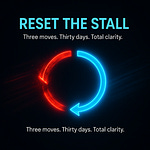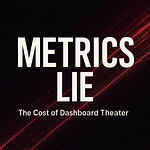Quick wins feel like momentum, but they’re usually just motion. This episode breaks down how “small victories” quietly destroy growth, credibility, and team capacity, and how to replace them with compounding systems that actually scale.
Every marketer loves a quick win.
The tiny dopamine spike of “we did something.”
The slide-worthy metrics. The quarterly applause.
But here’s the truth: most quick wins are quicksand.
They look like movement, but kill momentum over time.
THE HIDDEN COST OF QUICK WINS
Quick wins don’t just waste time; they compound damage.
They hijack attention.
Your team chases spikes instead of fixing systems.
Retention stays broken, churn stays high, and you stay “busy” with nothing to show for it.They erode credibility.
You can only promise short-term success so many times before leadership stops believing you.
Quick wins fade. Systems sustain.They burn capacity.
Every pivot to a new tactic resets the learning curve.
Your team never compounds knowledge; they just restart the tutorial every quarter.They create dependency on novelty.
Once your org gets addicted to the “next thing,” you’re stuck on the treadmill of tactics that don’t scale.
WHY WE CHASE THEM ANYWAY
It’s not stupidity, it’s wiring.
Quarterly pressure. You’re expected to show wins now, even when long-term strategy is what actually moves growth.
Dopamine loops. Quick wins feel productive. Long-term systems don’t.
Lack of systems training. Most leaders know how to run campaigns, not build infrastructure.
We chase quick wins because our incentives are broken, not because we’re weak
WHAT TO BUILD INSTEAD: MOMENTUM SYSTEMS
The cure for quick-win addiction isn’t slowness. It’s compounding systems.
1. Build repeatable plays.
Stop launching one-offs. Design plays that can run monthly, quarterly, and improve over time.
2. Create urgency-based offers, not discounts.
Dead discounts train customers to wait. Build real urgency through scarcity, timing, and structured bonuses.
3. Own the buyer’s questions.
Identify the 10–15 questions every buyer asks. Create definitive answers. Update them quarterly. This builds trust that compounds.
4. Use AI to cut cost or cycle time—not as theater.
If it doesn’t shorten time-to-impact, it’s not automation—it’s decoration.
HOW TO TRANSITION OUT OF QUICK WINS
Audit your last 3 quarters.
Ask: did this build compounding value or vanish after a week?Pick one system to build.
Not five. Just one with the biggest leverage (like retention, buyer enablement, or lead-to-demo flow).Design for compounding.
Ask: does this get better the longer it runs? If not—it’s not a system.Commit for two quarters.
Systems take time. You can’t judge compound growth on week two.Sell stakeholders on risk reduction.
“Building systems reduces our dependency on novelty.” That’s language execs understand.
SNAPSHOT
Quick wins aren’t free.
They cost you credibility, capacity, and clarity.
Every time you chase a spike, you trade compounding for dopamine.
Every time you pivot, you reset momentum.
Systems compound. Quick wins evaporate.
And the difference between teams that grow and teams that grind…
is who’s disciplined enough to stop chasing the next “win.”
If this hit hard, share it with the teammate or founder who can’t stop chasing hacks.
Then pick one system to build this quarter and commit to it.
Because growth doesn’t come from hacks, it comes from habits that compound.
Subscribe for weekly clarity passes that turn chaos into compounding growth.











